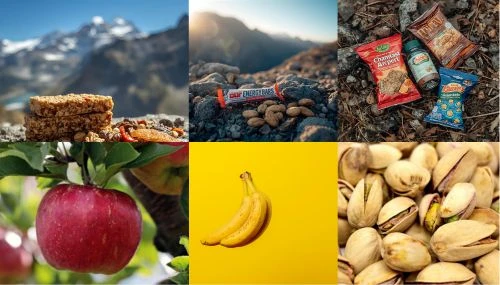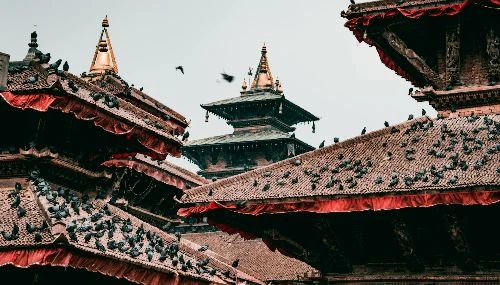The best time for the EBC trek in Nepal is during the spring and autumn seasons that is March to May and September to November. Spring and autumn offer unbeatable weather conditions making the trek both comfortable and visually stunning.
While spring brings vibrant blooms and mild weather, autumn, on the other hand, provides clear blue skies, moderate temperatures, and exquisite mountain vistas making it an ideal time for trekking.
Feeling a bit spontaneous? Summer (June to August) and winter (December to February) have their own set of rewards if you prepare for the challenges. Summer brings lush greenery but also the risk of rain and muddy trails.
Likewise, winter can be a magical time, with snow-covered landscapes and peaceful trails, but the freezing temperatures will make you wish you packed that extra pair of socks.
No matter when you choose to embark on your EBC journey, each season brings its magic to the mountains. However, making the right call on when to undertake this trek is important for a safe and enjoyable trip. Choosing the best season not only enhances the experience but also minimizes the risks that come with unpredictable weather.
The best season for an EBC trek can vary depending on factors such as temperature, precipitation, trail conditions, and crowd levels. Based on these factors, we’ve curated all the information in our blog to help you decide.
Peak Time/Seasons
Peak EBC trekking times in Nepal are during the Spring and Autumn seasons. Late March to mid-May and late September to November are the busiest months. And why wouldn’t it be? The weather is at its finest–Clear skies, crisp mountain air, and breathtaking views.
With great weather comes great crowds. The trails to EBC are filled with fellow trekkers and climbing enthusiasts from around the globe.
As per reports, about 40,000 visitors trek to Everest Base Camp each year, and during the peak seasons, up to 500 people can set out on the trek route every day.
Not to mention, the teahouses and lodges along the route can get packed, and securing accommodation in advance is highly recommended. With Sublime Trails, you can count on seamless travel arrangements every step of the way.
Best Time For EBC Trek
Spring Season (March to May)
Trekking in the spring season i.e. from March to May offers a perfect blend of favorable weather conditions, gorgeous scenery, and vibrant landscapes. You will witness nature’s beauty in full bloom.
With stable weather patterns and mild temperatures, your EBC adventure will be safe and enjoyable. Our Everest Three High Pass Trek or the classic Everest Base Camp Trek would be perfectly fine for this season.
Weather Conditions and Temperatures during Spring
The weather in spring is generally favorable. The lower elevations experience warmer temperatures and the higher elevations remain cooler.
Precipitation including rainfall and snowfall is less common during this season compared to other seasons. However, occasional rain showers or snowfall may still occur during the Everest Base Camp trek regardless of the chosen month.
In March, the average daytime temperature is around 7°C and nights can drop to around -12°C. Wind speeds peak during March, with gusts reaching over 20 km/h. We can expect about 7 hours of sunshine per day.
However, in April, daytime temperatures begin to rise, averaging around 10-12°C, with nights becoming milder. The weather is generally clear, ideal for trekking.
Likewise, temperatures continue to increase in May, with daytime highs reaching around 15°C. Nights are warmer, hovering around 0°C. Bright sunshine and warm weather, make it perfect for trekking.
Pros & Cons of Trekking during Spring
Pros | Cons |
Ideal weather in spring offers optimal visibility of the glorious Himalayan ranges. | Despite favorable weather, altitude sickness remains a concern. To ensure a safe trekking experience, proper acclimatization and hydration are important. |
Get to witness the scenic beauty of the landscapes along with blooming rhododendrons covering the hillsides and the fresh snow covering the majestic mountains. | As spring is the peak season, tea houses and hotels tend to be occupied quickly. Therefore, advance booking is necessary. |
Opportunities to spot yaks and other wildlife along the trails. | You may experience some heat haze during late April and May. |
Favorable for more adventurous and elaborate journeys like the Gokyo Lakes Trek. | During late March, the trails start to get busier but you can consider trekking alternative routes. |
Summer Season (June to August)
Trekking to Everest during the summer season, from June to August is challenging and rewarding at the same time. Warmer weather, tranquil routes, picturesque landscapes, and lower costs–couldn’t ask for more but the problem is monsoon rainfall.
Trekking during this season requires careful planning and consideration of the weather conditions and potential hazards that come with the monsoon season.
Weather Conditions and Temperatures during Summer
During the summer months, trekking to Everest Base Camp is full of ups and downs because of weather conditions.
Firstly, it is the monsoon rain. There’s not much rain in the upper parts of the Everest Base Camp trail but the lower parts experience heavy rain making paths muddy and slippery. The risk of landslide looms high adding an extra layer of danger to an already demanding trek.
During June, July, and August, the weather temperatures at EBC vary. Days can be hot, with temperatures around 18°C on average and sometimes reaching up to 25 °C. However, nights and early morning get pretty cold, especially at higher altitudes where it can drop to as low as -15°C. Not to forget, the wind typically blows at an average speed of around 16 km/h.
If you’re planning to trek during the summer, just remember to pack your rain gear, sunscreen, and thermals and you’ll be ready to tackle whatever Mother Nature throws your way.
Pros & Cons of Trekking during Summer
Pros | Cons |
|---|---|
Summer in the Everest region has milder temperatures, especially at lower altitudes which makes trekking comfortable during the day. | The monsoon clouds reduce the visibility of peaks like Everest, Lhotse, and others. |
Fresh greenery and blooming flowers along the trail. | Heavy rainfall increases the risk of landslides along the trail and also avalanches in certain areas. |
Fewer trekkers compared to peak seasons. You’ll be hiking in a peaceful lane. | High chances of Flight delays and cancelations due to poor weather conditions of monsoon. |
Better deals and more flexibility in accommodations and other services. | Encounter leeches along the trekking route, particularly lush forests. |
Autumn Season (September to November)
The Autumn season from September to November stands out as one of the best times to embark on an EBC adventure.
It is a once-in-a-lifetime experience that combines the thrill of adventure with the richness of Nepalese culture. What’s more, add a touch of luxurious stays, premium services, and scenic helicopter rides to it and you’ll get the Luxury EBC Trek.
From witnessing the vibrant festivities of the Mani Rimdu Festival to trekking through breathtaking landscapes, every moment offers a glimpse into life in the Himalayas. Moreover, the weather is on our side.
Weather Conditions and Temperatures during Autumn
Autumn in the Everest region offers stable weather conditions–clear skies and moderate temperatures. Here’s what you can expect in terms of weather and temperatures during September, October, and November.
September marks the start of autumn. The average daytime temperature ranges from 12°C to 15°C, while nights can drop to 5°C to -15°C at higher altitudes. We can expect around 8 hours of sunshine per day, with an average wind speed of 8-11 km/hr.
October also known as the pinnacle of autumn, boasts near-perfect weather conditions. The daytime temperatures hover between 12°C to 16°C, with nighttime temperatures ranging from 5°C to -14°C at higher elevations. We can enjoy approximately 6 to 7 hours of sunshine daily, accompanied by a similar average wind speed as in September.
November marks the beginning of colder days and occasional snowfall. The daytime temperatures vary from 9°C to 17°C, while nighttime temperatures can drop to around -20°C. We can expect around 6 to 7 hours of sunshine daily, with similar wind speeds as in September and October.
Pros & Cons of Trekking during Autumn
Pros | Cons |
|---|---|
As the weather is stable with clear skies and minimal rainfall, Autumn ensures excellent visibility. | Autumn is a peak trekking season meaning the trails will be crowded. |
Because of comfortable temperatures, daytime temperatures are pleasant which makes trekking enjoyable. | Many trekkers on the route lead to crowded accommodations and securing accommodation can be competitive. |
With approximately 7 hours of sunshine per day, trekkers have ample time to cover longer distances and allow more exploration. | Pre-booking of tea houses and other services is necessary due to the heavy flow of trekkers. |
Here’s our Everest Mani Rimdu Festival Trek package most favorable for the autumn season.
Winter Season (December to February)
Winter season is regarded as the off-season for trekking in the Everest region mainly due to extreme cold. Cold severe arctic winds, massive amounts of snow, and poor trekking conditions in winter welcome danger.
However, for those who enjoy trekking in quiet and peaceful trials, winter is the one but you must be well-prepared. The safest trip to embark on this winter would be our Everest View Trek package.
Weather Conditions and Temperatures during Winter
In the winter season, Everest region days are typically clear and partly sunny, however, temperatures drop significantly, especially at night.
December marks the beginning of winter when days are generally sunny and clear. Temperatures drop well below freezing, especially at night. The daytime temperatures hover around 4°C, while nighttime temperatures drop to -14°C. There will be around 5-7 hours of sunshine per day with average wind speeds ranging from 12-19k/hr.
Now comes the coldest month in Nepal, January. This month might bring more challenges for trekkers. Days are still partly sunny but the nights are bitterly cold with temperatures reaching below-freezing throughout the Everest region. If you want to reach your destination and escape the cold as fast as possible, you can arrange for the EBC Trek to end with a helicopter return.
Daytime temperatures remain around 4°C, while nighttime temperatures can drop to about -17°C. We can anticipate 5-7 hours of sunshine per day, with similar average wind speeds as in December.
In February, the temperatures gradually start to rise as spring approaches. Days become warmer with the daytime temperatures ranging around 4°C and night temperatures around -14°C. There will be 6 to 7 hours of sunshine per day, with average wind speeds similar to those in December and January.
Pros & Cons of Trekking during Winter
Pros | Cons |
|---|---|
As winter is the off-season, the routes and teahouses are crowd-free. | Harsh weather conditions make trekking difficult and potentially hazardous. |
If you get the right visibility of the mountains, the thick snow makes it even better. | There may be fewer accommodations and services available because some teahouses and lodges along the trail may be closed. |
The costs could be lower compared to peak trekking times. | As you’ll be facing colder temperatures there’s a higher risk of altitude-related issues. |
Because of the smaller crowd along the trail, there’s a high chance of seeing wild animals and birds such as tahrs, red pandas, bharal, Eurasian hoopoe, and many more. | As daylight hours are shorter, trekkers need to plan their routes accordingly ensuring they reach the destination before nightfall. |
Wrapping Up
As you saw in this blog, there’s no such thing as bad weather to trek in the Everest region, only bad clothing. If you prepare well and pack right, you can pull off an incredible trekking journey regardless of when you do it.
Gearing up to trek in the Everest region? Here’s our detailed packing list for Everest.







.webp)

